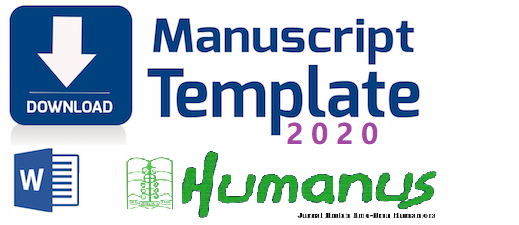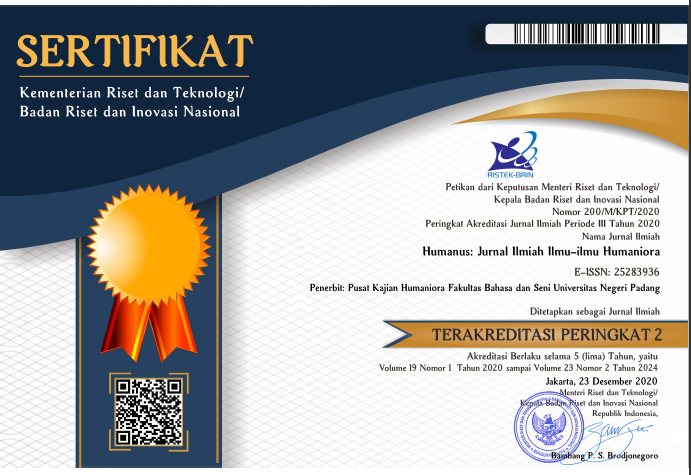The Metaphor of Solidarity and Hard Work in Batak Tobanese Tribe of North Sumatera
 ),
), (1) Universitas Negeri Yogyakarta
(2) Universitas Negeri Yogyakarta
 Corresponding Author
Corresponding Author
Copyright (c) 2021 Humanus
DOI : https://doi.org/10.24036/humanus.v20i1.113449
Full Text:
 Language : en
Language : en
Abstract
Keywords
References
Alesandro, D. (1997) Linguistic Antropology. Cambridge: Cambridge University Press
Atkinson, P.; Hammersley M (2007) Ethnography: Principles in Practice. 3ed. New York: Routledge
Nirmala, D. (2012) Fungsi pragmatik metafora dalam wacana surat pembaca berbahasa Indonesia. LITERA 11, (1),34-46 DOI: https://doi.org/10. 21831/ ltr.v1 1i1. 1141
Djayasudarma, T. Fatimah (1997) Nilai Budaya dalam Ungkapan dan Peribahasa Sunda. Jakarta: Pusat Pembinaan dan Pengembangan Bahasa
Farr M. and A.F. Ball (1999) Standard English. Dalam Spolsky. B 205 – 208
Foley, William A (1997) Antropological Linguistics. Massachusettes: Blackwell Publisher Inc.
Geertz, H. (1983) Keluarga Jawa. Jakarta: Grafiti Press
Gunarwan, A. (2004) Pragmatik, Budaya dan Pengajaran Bahasa. Makalah Seminar Nasional Semantik III, UNS : Surakarta
Prayitno, H.J.; Abdul N, Sutopo, A., Muhammad R, Tommi Y (2018) Power, Orientation, and Strategy of Positive Politeness used by Children at the Age of Elementary School with Javanese Cultural Background, Humanus 17(2), 164-173 DOI : https:// doi. org/10.24036/humanus.v17i2.101371
Koentjoroningrat (1994) Kebudayaan Jawa. Jakarta: Balai Pustaka
Kramsch, C. (1998) Language and culture. Oxford: Oxford University Press
Kridalaksana, H. (1982) Fungsi Bahasa dan Sikap Bahasa. Ende Flores: Nusa Indah
Kristiansen, G. et all (2006) Cognitive Linguistics: Current Applications and Future Perspectives. Berlin: Mouton de Gruyter
Lakoff, J. (2003) Metaphors We Live By. Chicago: Chicago University Press.
Larse. SE (2009) Semiotic. Diterjemahkan oleh Sudaryanto. Klaten: Program Pasca Sarjana
Liliweri, A. (2009) Dasar-dasar Komunikasi Antarbudaya.Yogyakarta: Pustaka Pelajar Universitas Widya Dharma
Lendik, L. S. (2017) Metaphor and the Representations of Health and Illness among the Semai Indigenous Community in Malaysia. GEMA Online® Journal of Language Studies 17(4),61-83. DOI:10.17576/gema-2017-1704-05
Moleong, L. J. (2017). Metode Penelitian Kualitatif, cetakan ke-36, Bandung: PT. Remaja Rosdakarya Offset
Nauly, M., & Fransisca, V. (2015). Identitas budaya pada mahasiswa Batak Toba yang kuliah di Medan. Jurnal Psikologi Ulayat: Indonesian Journal of Indigenous Psychology, 2(1), 364–380. http://doi: 10.24854/ jpu12015-32
Oktavianus (2006) Analisis Wacana Lintas Bahasa. Padang: Andalas University Press
Panahbar E.; Hesabi, A.; Pirnajmuddin, H. (2016) Aesthetics in the Relationship of Conceptual Metaphors and Cultural Models in the Translation of Rubayyat of Khayyam. 3 L Language, Linguistics, Literature 22 (3). 49-63. DOI: http://doi.org/10.17576/3L - 2016-2203-04
Ricoeur, P. (2005) Filsafat Wacana: Membelah Makna dalam Anatom Bahasa. Terjemahan Musnur Hery, Yogyakarta: IRCiSoD
Rinaldi, R. (2017) Retoric and Figure of Speech Minangkabau Locality in TonilScript Sabai Nan Aluih by Sutan Sati. Humanus 15 (2) ,118-129. DOI: http://doi.org.humanus. v16i1.7627locality
Sibarani, R. (2003) Semantik Bahasa Batak Toba. Jakarta: Pusat Bahasa Depdiknas
Simanjuntak, B. A. (2009). Konflik status dan kekuasaan Orang Batak Toba- Bagian Sejarah Batak. (Edisi Revisi). Jakarta: Yayasan Pustaka Obor Indonesia.
Simatupang, M. (1989) The life of the Batak. Makalah. Ganesha Tuesday Evening Lecture Series. Erasmus Huis. Jakarta
Soekamto (2004) Semantik Pragmatik Metonomi dan Metafora. Jakarta: Obor
Saad, S. M.(2018) Conceptual Metaphor and Linguistic Manifestations in Malay and French: A Cognitive Analysis. GEMA Online Journal of Language Studies Volume 18(3), 114-134 http://doi.org/10.17576/gema-2018-1803-07
Ungerer, F & H.J. Schmid. 1996. An Introduction toCognitive Linguistics. London: Longman
Wahab, A. (1995) Metafora sebagai Alat Pelacak Sistem Ekologi. Yogyakarta: Penerbit Kanisius.
Wijana, I D. P. (2004) Relasi Bahasa dan Budaya serta Berbagai Permasalahannya. Semiotika. V 5 (2)/2004
Sohrabi, Z., Pirnajmuddin, H. (2011) Metaphors as Ideological Constructs for Identity in Malaysian Short Stories. 3 L Language, Linguistics, Literature Vol.17. (Special Issue): 99 – 107
 Article Metrics
Article Metrics
 Abstract Views : 463 times
Abstract Views : 463 times
 PDF Downloaded : 127 times
PDF Downloaded : 127 times
Refbacks
- There are currently no refbacks.
Copyright (c) 2021 Humanus

This work is licensed under a Creative Commons Attribution-NonCommercial 4.0 International License.











